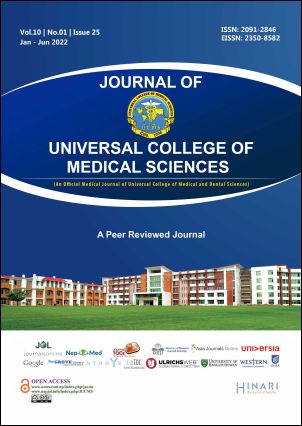An Observational Study on Root Canal Morphology of Mandibular Incisors in a Dental College Hospital
DOI:
https://doi.org/10.3126/jucms.v10i01.47241Keywords:
Cone-beam computed tomography, Extra canal, Mandibular incisor, Root canal morphologyAbstract
INTRODUCTION
Additional canals are frequent findings in radicular morphology of the mandibular incisors. Finding additional canals and their obturation significantly improve the prognosis of endodontic treatment. Cone Beam Computed Tomography (CBCT) best visualize all canals and their configurations. The study assessed root canal anatomy of mandibular incisors on CBCT images of the patients.
MATERIAL AND METHODS
An observational cross-sectional study was carried during July-October 2021 on 42 CBCT images of the patients visiting Kantipur Dental College and Hospital. The samples were selected using convenience sampling presenting with bilateral mandibular central and lateral incisors. Root canals and their configurations were assessed on 168 teeth. The presence of unilateral or bilateral additional root canal was recorded and chi-square test was used to test its association with gender (p < 0.05).
RESULT
The prevalence of additional canal was 27.4% in mandibular incisors. Bilateral symmetrical distribution of extra canal in mandibular central and lateral incisors were 36.3% and 41.6% respectively. There was a significant association between the presence of extra canal and gender in both central incisors (p-value 0.019) and lateral incisors (p-value 0.009). Type I canal configuration was most prevalent (72.6%) followed by Type III (22.6%).
CONCLUSION
The prevalence of double canals in mandibular incisors is 35% in male and 4% in female samples confirming the male predominance. Bilaterally symmetrical occurrence of double canal is evident up to 41%. CBCT evaluation helps in the visualization of missing root canals during endodontic therapy.
Downloads
Downloads
Published
How to Cite
Issue
Section
License
Copyright (c) 2022 Journal of Universal College of Medical Sciences

This work is licensed under a Creative Commons Attribution-NonCommercial 4.0 International License.
Authors have to give the following undertakings along with their article:
- I/we declare that this article is original and has not been submitted to another journal for publication.
- I/we declare that I/we surrender all the rights to the editor of the journal and if published will be the property of the journal and we will not publish it anywhere else, in full or part, without the permission of the Chief Editor.
- Institutional ethical and research committee clearance certificate from the institution where work/research was done, is required to be submitted.
- Articles in the Journal are Open Access articles published under the Creative Commons CC BY-NC License (https://creativecommons.org/licenses/by-nc/4.0/)
- This license permits use, distribution and reproduction in any medium, provided the original work is properly cited, and it is not used for commercial purposes.




